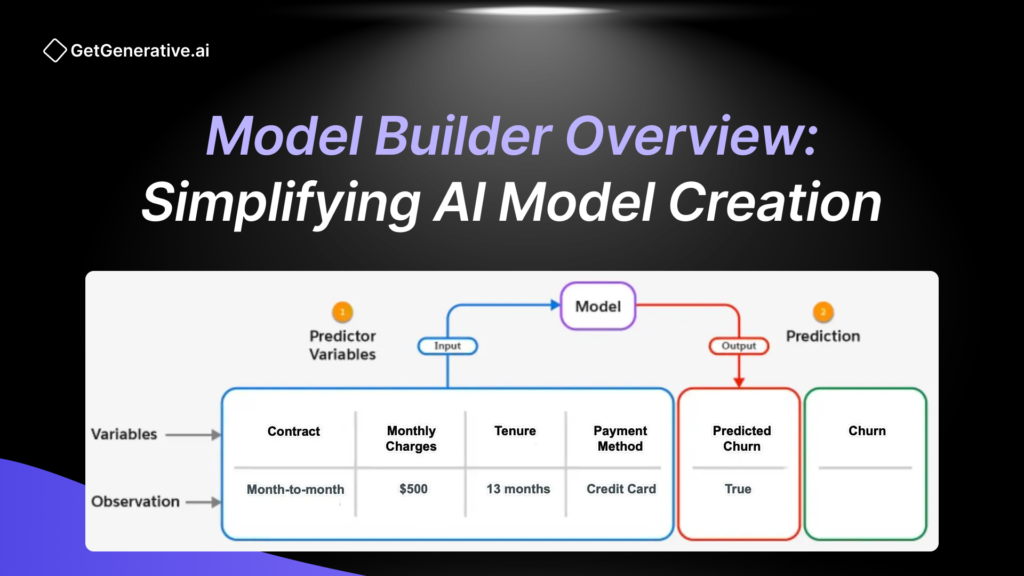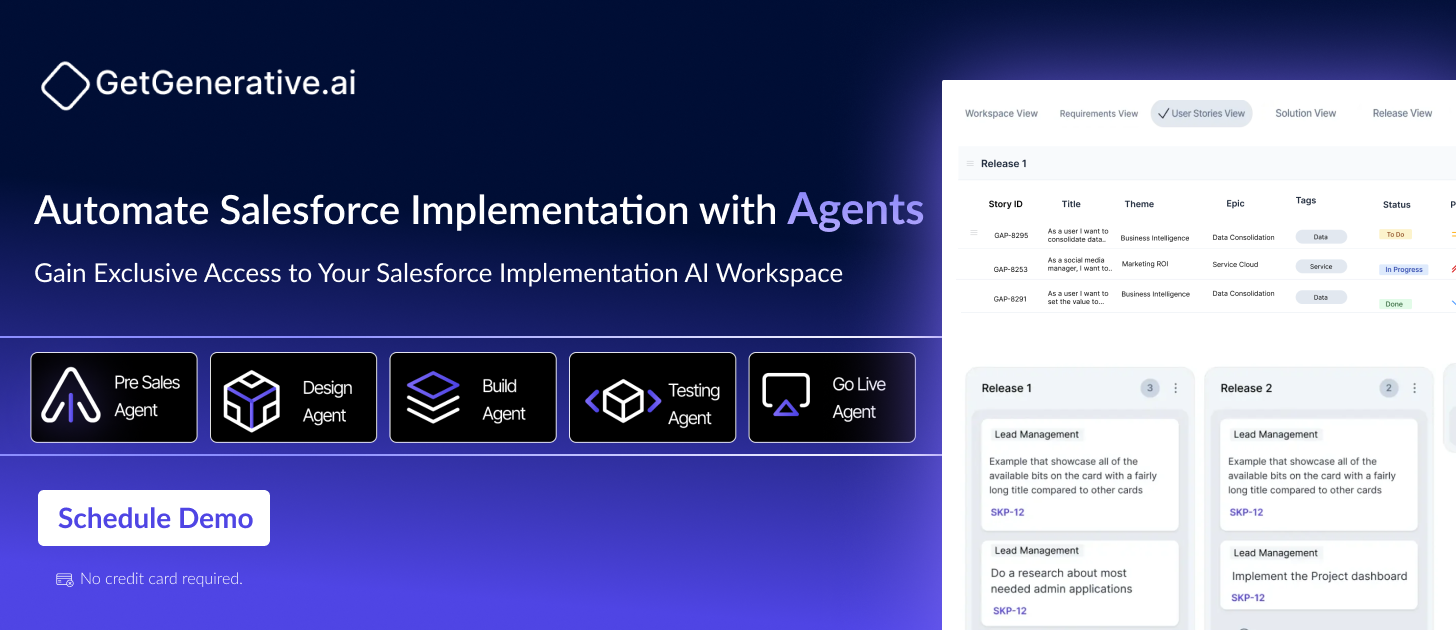Model Builder Overview: Simplifying AI Model Creation
With platforms like Salesforce Model Builder, Corestrat’s Model.ai, and Microsoft AI Builder, organizations are finding new ways to leverage AI effectively. These tools empower users to create, train, and deploy machine learning models without requiring extensive expertise in data science.
Understanding AI Model Builders
AI model builders simplify the traditionally complex process of developing AI models. They provide intuitive interfaces and automation features that allow developers, analysts, and non-technical users to participate in AI projects. These tools are designed to reduce repetitive tasks, enabling organizations to focus on strategic objectives.
Salesforce’s Model Builder offers unique features such as pre-configured LLMs, BYOM (Bring Your Own Model) capabilities, and integration with the Einstein Trust Layer for secure data management. Meanwhile, Corestrat’s Model.ai is a no-code platform catering to business needs with AutoML capabilities and real-time model monitoring. Microsoft AI Builder enhances the Power Platform experience by embedding cutting-edge Azure AI functionalities into low-code solutions.
Key Features that Drive Adoption
No-Code Interfaces
Platforms like Model.ai and AI Builder cater to non-technical users, enabling them to build predictive models without programming. By eliminating technical barriers, these platforms empower more individuals to harness the potential of AI for their specific business needs.
Generative AI Integration
Generative AI capabilities allow businesses to automate tasks like text generation, summarization, and conversational AI. Salesforce Model Builder integrates popular LLMs like OpenAI’s GPT and Amazon’s Bedrock, enabling organizations to deploy AI solutions across a variety of scenarios, from chatbots to content creation.
Secure and Flexible Integration
AI model builders support multiple large language models and allow for the integration of custom models. Salesforce’s BYOM feature enables organizations to bring in their own models while maintaining complete control over data and infrastructure.
Centralized Monitoring
Dashboards provide real-time insights into model performance, highlighting key metrics like accuracy, variable importance, and output explainability. These visualizations simplify decision-making and ensure models align with business goals.
Also Read – The Ultimate Salesforce Model Builder Cheat Sheet
Benefits of AI Model Builders for Businesses
AI model builders provide unparalleled benefits, helping businesses streamline their operations and make data-driven decisions more efficiently. From cost savings to improved scalability, these tools offer transformative advantages.
Accelerating Development Timelines
Traditional AI model development can take weeks or even months. AI model builders automate time-intensive tasks like data preprocessing and algorithm selection, enabling businesses to deploy AI solutions rapidly. For instance, Corestrat’s Model.ai reduces repetitive tasks, allowing data scientists to focus on more critical analyses.
Enhancing Accessibility
With intuitive, no-code interfaces, platforms like Microsoft AI Builder enable non-technical users to engage with AI projects. By democratizing AI development, these tools ensure that businesses of all sizes can leverage machine learning without needing a team of data scientists.
Reducing Costs
Building AI models in-house often requires significant investments in resources and expertise. AI model builders eliminate the need for custom development from scratch, reducing costs while maintaining high-quality outcomes.
Improving Model Accuracy
Automation minimizes human errors that can occur during data processing or algorithm selection. Features like AutoML and continuous learning in Corestrat’s Model.ai ensure that models improve over time, delivering accurate and actionable insights.
Facilitating Scalability
As businesses grow, their data and AI needs expand. AI model builders are designed to handle large datasets and complex use cases, making it easier to scale operations without overhauling infrastructure.
Also Read – The Ultimate Salesforce Prompt Builder Cheat Sheet
Maximizing the Potential of AI Model Builders
To fully leverage the capabilities of AI model builders, businesses must adopt best practices and strategic approaches:
Start with Simple Projects
Begin with manageable AI projects to familiarize your team with the platform’s features. Gradual adoption allows for learning and minimizes initial risks.
Invest in Training and Support
Leverage the extensive documentation, tutorials, and community support provided by platforms like Salesforce Model Builder and Microsoft AI Builder. Proper training ensures users can maximize the tools’ potential.
Also Read – Einstein Prediction Builder: Empowering Salesforce With AI-Driven Insights
The Future of AI Model Builders
AI model builders are poised to become even more powerful with advancements in generative AI, automated workflows, and integration capabilities. As these tools evolve, businesses can expect:
- Increased Interoperability: Seamless integration with diverse platforms and tools for broader use cases.
- Real-Time Analytics: Enhanced capabilities for processing and responding to live data streams.
- Deeper Customization: Greater flexibility to tailor AI models to unique business needs.
- Improved Accessibility: Further simplification of interfaces to make AI development universally accessible.
Conclusion
AI model builders like Salesforce Model Builder, Corestrat’s Model.ai, and Microsoft AI Builder are changing the way businesses approach AI development. By simplifying workflows, enhancing accessibility, and ensuring scalability, these tools empower organizations to unlock the full potential of their data.
To learn more, visit GetGenerative.ai.
FAQs
1. Can AI model builders handle large datasets?
Yes, most platforms, such as Salesforce Model Builder and Corestrat Model.ai, are designed to handle extensive datasets and complex scenarios efficiently.
2. How secure are AI model builders?
Platforms like Salesforce Model Builder integrate security features like the Einstein Trust Layer to ensure data privacy and compliance.
3. What industries benefit most from AI model builders?
Industries like retail, finance, healthcare, and supply chain logistics benefit significantly from the predictive and operational capabilities of AI model builders.




